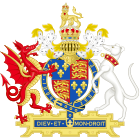A suffragan bishop is a type of bishop in some Christian denominations.

The Archbishop of Westminster heads the Roman Catholic Diocese of Westminster, in England. The incumbent is the metropolitan of the Province of Westminster, chief metropolitan of England and Wales and, as a matter of custom, is elected president of the Catholic Bishops' Conference of England and Wales, and therefore de facto spokesman of the Catholic Church in England and Wales. All previous archbishops of Westminster have become cardinals. Although all the bishops of the restored diocesan episcopacy took new titles, like that of Westminster, they saw themselves in continuity with the pre-Reformation Church and post-Reformation vicars apostolic and titular bishops. Westminster, in particular, saw itself as the continuity of Canterbury, hence the similarity of the coats of arms of the two sees, with Westminster believing it has more right to it since it features the pallium, a distinctly Catholic symbol of communion with the Holy See.

The Ecclesiastical Appeals Act 1532, also called the Statute in Restraint of Appeals, the Act of Appeals and the Act of Restraints in Appeals, was an Act of the Parliament of England.
The General Synod is the tricameral deliberative and legislative organ of the Church of England. The synod was instituted in 1970, replacing the Church Assembly, and is the culmination of a process of rediscovering self-government for the Church of England that had started in the 1850s.
The Bishop of Bedford is an episcopal title used by a Church of England suffragan bishop who, under the direction of the Diocesan Bishop of St Albans, oversees 150 parishes in Luton and Bedfordshire.

The Ecclesiastical Licences Act 1533, also known as the Act Concerning Peter's Pence and Dispensations, is an Act of the Parliament of England. It was passed by the English Reformation Parliament in the early part of 1534 and outlawed the payment of Peter's Pence and other payments to Rome. The Act remained partly in force in Great Britain at the end of 2010. It is under section III of this Act, that the Archbishop of Canterbury can award a Lambeth degree as an academic degree.

The Appointment of Bishops Act 1533, also known as the Act Concerning Ecclesiastical Appointments and Absolute Restraint of Annates, is an Act of the Parliament of England.
The modern Bishop Suffragan of Dorchester in the Diocese of Oxford, usually contracted to Bishop of Dorchester, is an episcopal title used by an area bishop of the Church of England Diocese of Oxford, in the Province of Canterbury, England. The Bishop of Dorchester, along with the Bishop of Buckingham and the Bishop of Reading, assists the Diocesan Bishop of Oxford in overseeing the diocese.

The Bishop of Dover is an episcopal title used by a suffragan bishop of the Church of England Diocese of Canterbury, England. The title takes its name after the town of Dover in Kent. The Bishop of Dover holds the additional title of "Bishop in Canterbury" and is empowered to act almost as if the Bishop of Dover were the diocesan bishop of Canterbury, since the actual diocesan bishop is based at Lambeth Palace in London, and thus is frequently away from the diocese, fulfilling national and international duties. Among other things, this gives the Bishop of Dover an ex officio seat in the church's General Synod. There is another suffragan, the Bishop of Maidstone, who has different responsibilities.
The Bishop of Edmonton is an episcopal title used by an area bishop of the Church of England Diocese of London in the Province of Canterbury, England. The title takes its name after Edmonton, an area in the North of the London Borough of Enfield; the See was erected under the Suffragans Nomination Act 1888 by Order in Council dated 29 May 1970.
The Bishop of Colchester is an episcopal title used by an area bishop of the Church of England Diocese of Chelmsford, in the Province of Canterbury, England.
The Bishop of Penrith is an episcopal title which takes its name after the town of Penrith in Cumbria.
The Bishop of Wolverhampton is an episcopal title used by a suffragan bishop of the Church of England Diocese of Lichfield, in the Province of Canterbury, England. The title takes its name after the city of Wolverhampton in the West Midlands; the See was erected under the Suffragans Nomination Act 1888 by Order in Council dated 6 February 1979. The Bishop of Wolverhampton has particular episcopal oversight of the parishes in the Archdeaconries of Lichfield and Walsall. The bishops suffragan of Wolverhampton have been area bishops since the Lichfield area scheme was erected in 1992.
In British law and in some related legal systems, an enactment is spent if it is "exhausted in operation by the accomplishment of the purposes for which it was enacted".

The Interpretation Act 1889 was an act of the Parliament of the United Kingdom.

The Forgery Act 1830 was an Act of the Parliament of the United Kingdom. It consolidated into one Act all legislation imposing the death penalty for forgery. Two years later the death penalty was abolished for most of these offences, and for the remaining offences in 1837.

The Statute Law (Repeals) Act 1969 is an act of the Parliament of the United Kingdom.

The Statute Law (Repeals) Act 1977 is an Act of the Parliament of the United Kingdom.

The Statute Law (Repeals) Act 1978 is an act of the Parliament of the United Kingdom.

The Ecclesiastical Commissioners Act 1847, sometimes called the Bishopric of Manchester Act 1847, is an Act of the Parliament of the United Kingdom with the principal purpose of delegating to the Ecclesiastical Commissioners for England the power to put forward a scheme to create the Diocese of Manchester. The Ecclesiastical Commissioners scheme containing the precise arrangements for the diocesan changes was put forward to Queen Victoria at Osborne House in the Isle of Wight, on 10 August 1847, where it was assented to in Chambers.






